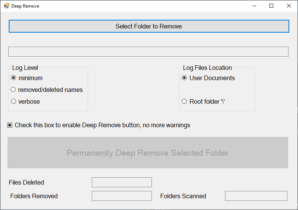
To force reference to the Pri.LongPath types simply create aliases to them with the using directive: Referencing the entire Pri.LongPath namespace will cause conflicts with System.IO because you almost always need to reference something else in System.IO. So, you really only need to force reference to the LongPath types. The APIs provided have been made identical to the System.IO APIs as best I could (if not, please log an issue fork and provide a failing unit test or fork, fix, add passing test).
#Long path tool full#
It's usually easiest just to grant full control to your user on the root LongPath directory (and let it inherent to children). Note: the units test currently expect that the user running the tests has explicit rights (read/write/create) on the TestResults directory and all child directories. Resolving this conflict is easily solved through aliases (see below).
#Long path tool code#
I feft that not having to modify your code was the greater of the two evils. Obviously to replace only 6 types in a namespaces ( System.IO) and not the rest is problematic because you're going to need to use some of those other types ( FileNotFoundException, FileMode, etc.)-which means referencing System.IO and re-introducing the original 6 types back into your scope.

You simply reference the Pri.LongPath types you need and you don't need to change your code. LongPaths allows your code to support long paths by providing a drop-in replacement for the following System.IO types: FileInfo, DirectoryInfo, FileSystemInfo, FileInfo, DirectoryInfo, FileSystemInfo.

#Long path tool windows#
(with one caveat: Directory.SetCurrentDirectory, Windows does not support long paths for a current directory). So, I drastically expanded the API scope to include FileInfo, DirectoryInfo, FileSystemInfo to get 100% API coverage supporting long paths. LongPath originally started as a fork of LongPaths on Codeplex but after initial usage it was clear that much more work was involved to better support long paths. You can likely support long paths with the above-mentioned libraries, but you end up having to scrub your code and re-design it to suit these new APIs (causing full re-tests, potential new errors, potential regressions, etc.).
#Long path tool software#
"When I use a path like c:\users\ 300 chars removed\Document.docx your software gives me an error". Usually after you've released something and someone logs bug (e.g. Often times long path support is an after thought. But, these libraries do not seem to support the entire original API ( Path, File, Directory) and not all file-related APSs (including FileInfo, DirectoryInfo, FileSystemInfo). NET in classes like LongPath LongPathFile and LongPathDirectory. Several attempts like (which a more up to date version has made its way into.

This makes it hard to entirely support long paths in any application, let alone in. The file system (NTFS), for example, supports long paths quite well but other things like Command Prompt and Explorer don't. Unfortunately, other aspects of Windows haven't supported long paths in their entirely. Supporting files and directories with a long path is fairly easy with Windows. Instead of this package, You may want to consider native support for long paths in Windows 10≥:Įnable Long Paths in Windows 10, Version 1607, and Later LONG PATH Tool works on any Windows version (NT/2000/XP/Vista/Windows 7).Ĭan delete files even from mapped network foldersĬan list files and paths which have file path more than 200 characters long.A drop-in library to support long paths in. Our program LONG PATH Tool can handle pathnames of any length, up to the internal Windows limit of 32,000 characters.įast speed of long path folder/files search. Windows Explorer/FAR would fail to copy/delete/rename any pathname longer than 256 characters. If yes, our progam will be helpful for you. Make sure the disk is not full or write-protected and that the file is not currently in use. The file is in use by another program or user.

The source or destination file may be in use.


 0 kommentar(er)
0 kommentar(er)
